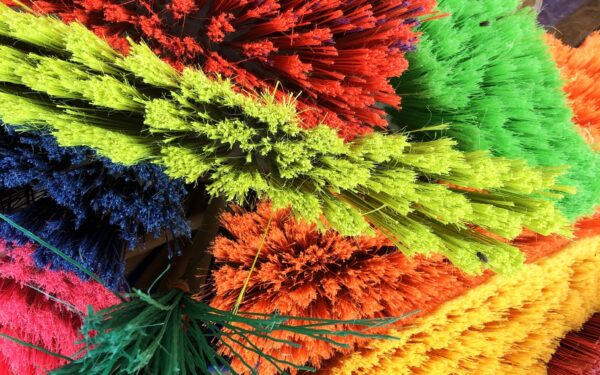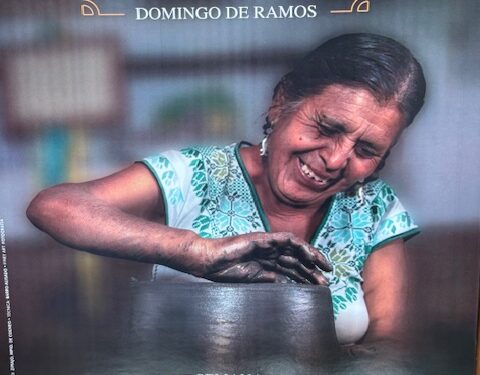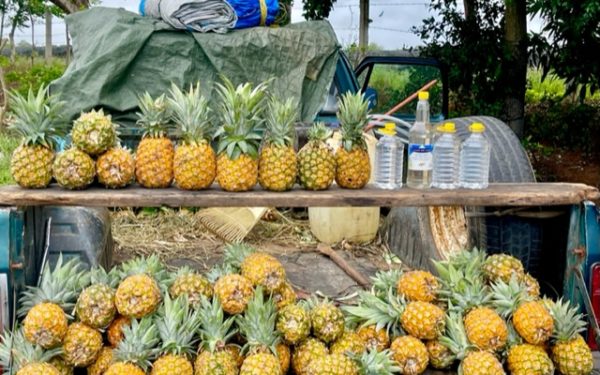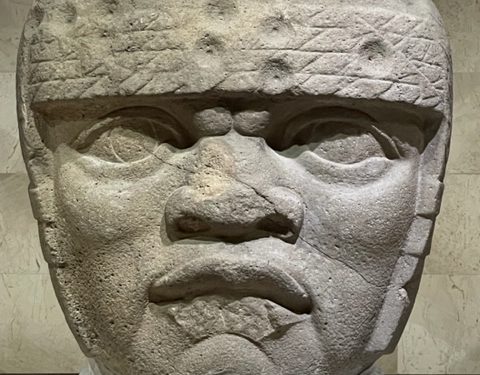“The whole point is to live life and be – to use all the colors in the crayon box.” RuPaul

Oaxaca Day Four … today’s experience is all about archaeology, black pottery, alebrijes and La Ruta de Artesanos. A short drive up a mountain road brought us to Monte Albán, a large pre-Columbian archaeological site just west of Oaxaca.
The partially excavated civic ceremonial center of Monte Albán is situated atop an artificially leveled ridge with an elevation of 6,400‘ above sea level. Besides being one of the earliest cities of Mesoamerica, Monte Albán’s importance stems also from its role as the pre-eminent Zapotec socio-political and economic center for close to a thousand years. The ancient Zapotec name of the city is not known, as abandonment occurred centuries before the arrival time of the Spaniards.
We walked and climbed its pyramid-like structures as our guide, Juan, filled our heads with facts and stories … with soft breezes and a sky of puffy white clouds acted as a backdrop to an unrealistically beautiful setting.
Our next stop … the pottery workshop of Fidel Martinez in the artisan town of San Bartolo Coyotepec. This visit became one of those “it’s a small world” moments as it turns out Fidel is one of the artists featured at our recent Art Feria. He sculpts the Barro Negro pottery (“black clay”) into beautiful figurines and thematic images The bulk of his work is commissioned pieces; his teenage son is also an artist with several local winners’ ribbons specializing in miniatures We did buy a tiny water carrier.
The black clay pottery is a distinguishing style originating from Oaxaca, Mexico, with its unique color, sheen, and designs. The origins of this work extend as far back as the Monte Albán period and for almost all of its history, had been available only in a grayish matte finish. Eventually, a way was devised to put a black metallic-like sheen onto the surface by polishing it before firing was discovered.
The color of barro negro is due to the properties of the clay and is not colored. The earth used to extract the clay is cleaned to remove impurities, which can take a month of soaking and settling out the clay from the rest of the soil.

Many different kinds of objects are made of barro negro including pots, whistles, flutes, bells, masks, lamps, animal figures; most being of a decorative nature and not for the storage of food and water.
Back on the road and driving deeper into The Artisans Route in the South Valley and it was lunchtime before the next eye-opening experience. My lunch was one of the best Chile Rellenos ever – rather than using the customary Chile Poblano, they used a local chile called “Chile de agua.” It’s more flavorful than a poblano and they don’t smother it in the sauce so the flavor of the chile is not diluted. David had Pechuga de Colibrí (hummingbird) a very colorful chicken dish smothered in green sauce and sprinkled with pomegranate seeds and nuts.
Alebrijes (Spanish pronunciation: [aleˈβɾixes]) are brightly colored Mexican folk art sculptures of fantastical (fantasy/mythical) creatures. The first alebrijes, along with the use of the term, originated with Pedro Linares, in 1930s Mexico City. He’d felt very ill and while in bed, unconscious, Linares dreamt of a strange place resembling a forest. There he saw trees, animals, rocks, clouds that suddenly turned into strange kinds of unknown animals. He saw a donkey with butterfly wings, a rooster with bull horns, a lion with an eagle head and all of them were shouting one word, “Alebrijes.” Upon recovering, he began recreating the creatures he saw in cardboard and paper-mâché.
The Oaxaca valley area already had a history of carving animals and other types of figures from a local tree, the Copal. Linares demonstrated his designs on family visits and they were adapted to the carving of this type of wood and are said to be magical.
Tilcajete, the town most closely associated with alebrije production in Oaxaca, has produced a number of notable artisans – we visited the workshop of Jacobo Angeles, although the town streets are crowded with workshops all displaying its colorful and unimaginable figurines. The craft has become part of Mexico’s folk art repertoire. And like snowflakes, no two alebrijes are exactly alike.

Jacobo Angeles’ designs were part of the inspiration for the Disney animated film, “Coco” … in fact, the grandma was based on an actual woman working at the workshop (unfortunately, she was off this day). We were shown the complete, detailed process of producing a single piece…….natural pigmentation is painstakingly painted on their commissioned pieces. The master painters are given complete freedom to use only their imaginations in creating colorful and intricate patterns.
We were lucky to walk away with just a hummingbird and a little penguin that David fell in love with, but as we are walking out of the workshop a real-life Alebrijes appeared before my eyes – a red-crested Xolo from out of the “Coco.” I was ready to cash my plane ticket for a bus ticket so I can bring home my new spirit animal.

Exhausted, we got into the car, but wait …we had one more stop …the town of Santo Tomas Jalieza, to see the old, basic, primitive (all words that spring to mind) and humble backstrap loom– a description that obscures the fact that some of history’s most beautiful and complex textiles have been woven on this simple arrangement of sticks.
We watched as our weaver strapped herself to the loom, arranged her sticks and I fell into a spell as she pulled her colored strings manually back and forth with her floating needles and a beautiful pattern was revealed before my eyes. David suggested we consider a piece and my wallet was burning in my jeans. We walked away with a smile, but also a beautiful black and white table runner, and David also bought a striking blue messenger bag.
Back to Oaxaca and in search of a little cafe to grab dinner, we came across large families out for a lovely Saturday night – the zócalo was abuzz with parents and children enjoying sidewalk performers and a myriad of street food choices.
Tomorrow ~ Mitla!











